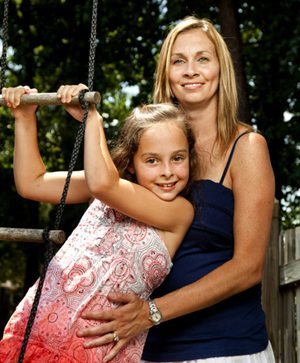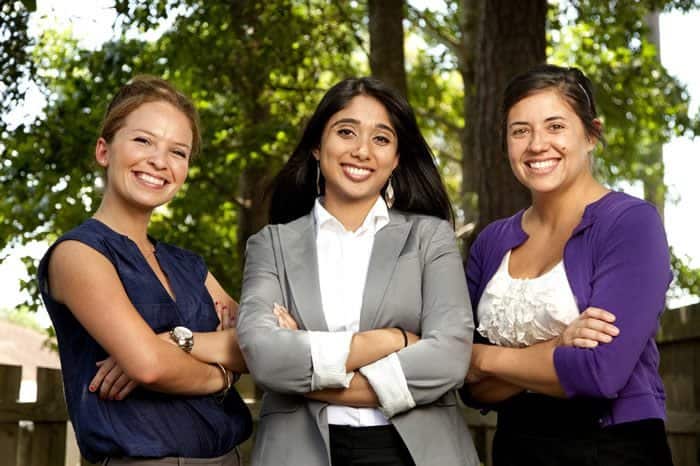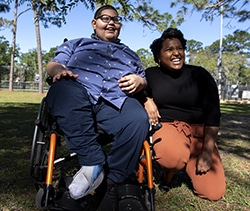
Ashlyn Sikes, 8
Sparkly. An eager, cheerful learner.
Ashlyn Sikes’ teacher used these words to describe the Tallahassee second-grader, who finished out the school year with her best report card ever.
” I love her enthusiasm for school,” commented the teacher.
Ashlyn’s parents, Adam and Amy Sikes, are proud of their 8-year-old daughter, but they also credit four Florida State University law students for her successful second-grade finish.
It was only with the students’ help that the Sikes were able to salvage for their daughter what started out to be an agonizing year.
Ashlyn’s love of school had come naturally starting in kindergarten, but her ability to master skills had not. From Ashlyn’s preschool years, her parents had noticed she had difficulties with fine-motor skills, speech, reading, short-term memory and attention span. The more advanced the classroom material became, the further behind she fell. The sense of failure took a heavy toll on Ashlyn.
By second grade, she was a different child.
“She had become withdrawn, and her confidence was at rock-bottom,” Adam said.
“My smiling, happy daughter now complained of headaches and stomachaches daily in an attempt to avoid school.”
The Sikes were notified shortly before the end of the first grading period of the 2010-11 school year that Ashlyn would be marked as failing or significantly behind in all subject areas.
Heartbroken at the impact Ashlyn’s academic struggles were having on their once bubbly and outgoing little girl, they turned to a center at FSU’s College of Law whose Health Care Access/Special Education Project is funded by The Florida Bar Foundation through a $127,720 Children’s Legal Services grant.
“We sought the assistance of the Public Interest Law Center in the fall of 2010 to help us understand, and fight for, our daughter’s rights to a free and appropriate public education,” Adam said.
By that time, the Sikes had already done everything they could to help Ashlyn on their own. They had taken her to see a doctor specializing in developmental issues and learning disabilities. At the suggestion of the school administration, they had paid dearly for a private evaluation in an effort to speed up the process of getting her help.

Ashlyn Sikes, 8, and her mother Amy enjoy a moment together in their backyard. Amy and her husband Adam are extremely grateful for the legal assistance they received from four law students at the Florida State University Public Interest Law Center, which is funded through a Florida Bar Foundation Children’s Legal Services grant. – See more at: http://www.flabarfndn.org/about/news-publications/newsletter/ashlyn.aspx#sthash.cCjPHtip.dpuf
But the same school administration then ignored the report. No changes were made to Ashlyn’s Individualized Education Program (IEP), the document that establishes her educational needs and rights under the Individuals with Disabilities Education Act. The only documented intervention in place was a weekly 15-minute session of speech therapy. Ashlyn’s other disabilities went unaddressed.
Amy finally couldn’t hold back the tears when she was told by the school’s Exceptional Student Education (ESE) liaison that putting Ashlyn in a special education class would stigmatize her.
“How could the liaison for the ESE program perpetuate the stigma associated with ESE, yet be oblivious to the fact that failing has a far greater stigma, and would be psychologically more damaging to Ashlyn?” Amy said.
The Sikes were later told Ashlyn didn’t need help to improve her handwriting, since nowadays everyone uses computers.
At the time, Ashlyn was scoring below grade level on standardized writing tests, but because the deficits with her fine-motor skills were not addressed in her IEP, her teacher could not make accommodations for her, nor was Ashlyn receiving occupational therapy to improve her writing.
Oaj Gilani, then a second-year law student, was taking a course at the Public Interest Law Center, led by managing attorney Paolo Annino, when she and her classmate Carolyn DeVita inherited Ashlyn’s case from fellow students Valentina Villalobos and Vanessa Ritter, who had taken it up in the fall.
Armed with knowledge and documentation of the laws and policies governing Ashlyn’s educational rights, Gilani and DeVita accompanied the Sikeses to meetings with school officials for the purpose of getting the school to include the educational services Ashlyn needed in her IEP. Among other things, they knew that if a parent requests an intervention on behalf of a child, the school has 60 days from the date of the request to conduct an evaluation of the need.
“There were some tough meetings with the school where school-board staff ignored or attempted to intimidate Carolyn and Oaj,” Adam said. “In the face of this adversity, Carolyn and Oaj always stood their ground and impressed me with their professionalism, knowledge and tenacity.”
Gilani said IEP meetings are supposed to involve a team approach, with everyone working together in the best interest of the child, but their initial meeting was nothing like that. Although she and DeVita were there to represent Ashlyn, she said the school representative was dismissive.
“She wouldn’t look at us or even recognize our presence. Every time I tried to talk, she would cut me off,” Gilani said. “Once we were able to get her to talk to us we were able to reach an agreement.”

Three of the four members of Ashlyn’s FSU Public Interest Law Center Dream Team: (from left) Vanessa Ritter, Oaj Gilani and Carolyn DeVita. Not pictured is Valentina Villalobos.
For Gilani, it was a compelling lesson in what it means to be a lawyer.
“In the law school setting, you’re used to getting so much theory and case law, but it doesn’t make sense until you have to apply it,” Gilani said. “I was really amazed at how just our involvement was able to help them so much.”
Among the things now included in Ashlyn’s IEP are the auditory presentation of materials, the ability to dictate written responses, modified testing, placement into an ESE class for writing, reading and math, and continued speech therapy. Amy points out that the ESE class is a much smaller setting with more one-on-one instruction.
“The IEP was more than an immediate help for Ashlyn; it ensures future academic success throughout her educational career,” Amy said.
Amy and Adam are still awaiting the full evaluation that is required to make occupational therapy a part of the IEP. But in the meantime, Ashlyn’s ability to dictate her writing tests enabled her to improve her scores by two or three grade levels last spring.
The Sikeses stress that Ashlyn has always had great teachers, but in some cases those teachers weren’t able to provide their daughter with certain services or accommodations because her needs weren’t documented in her IEP. It was only with the law students’ help that they were able to expand the IEP to include more than just speech therapy. Once that happened, and Ashlyn began receiving more interventions and accommodations, she immediately began improving in all areas.
Annino said Ashlyn’s story is typical of the Public Interest Law Center’s special education cases, which make up about a third of the center’s 60 ongoing cases.
“They were dragging their feet on getting the evaluations this little girl needed,” Annino said.
These days, Ashlyn has her sparkle back. She enjoys helping her mom cook, playing outside with friends, going on family bike rides, and doing absolutely anything her sister Abigail, 10, is doing.
She’s the kid who walks down the hall at school and gets showered with calls of “Hey, Ashlyn!”
Because there’s just something irresistible about a little girl who sparkles.
The Sikeses will be forever grateful to Gilani and DeVita, as well as their fellow law students Villalobos and Ritter, who worked on the case originally.
“I am, in ways words cannot describe, indebted to each of these individuals,” Adam said in an e-mail to the president of FSU, the dean of the law school, and everyone involved in the case at the Public Interest Law Center.
“My daughter is no longer being left behind. She enjoys school again. Her confidence is returning. She is smiling again. Ashlyn is learning that she can succeed, and this would not be the case without them. I am not able to fully express my appreciation for giving me my daughter back.”
Gilani, in turn, believes Adam and Amy Sikes are the ones to be commended.
“A lot of parents have these problems, but they don’t know how to approach the school, or if they do and are discouraged from proceeding, they usually do stop after a while,” Gilani said. “A lot of it was their effort. We wouldn’t have been involved if they hadn’t been so adamant about making sure Ashlyn was getting what she needed.”
But the Sikeses believe also that were it not for the funding the Foundation provides the Public Interest Law Center, their daughter might still be struggling. Adam shared his appreciation with the Foundation’s board in another e-mail.
“I extend my heartfelt thanks to each of you as well, for your generous donation of time, energy, and financial resources in support of The Florida Bar Foundation,” Adam wrote. “Your donations provide advocacy for those that would otherwise have none. Your generosity has made a monumental difference in the life and future of my child.”



